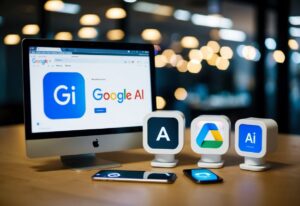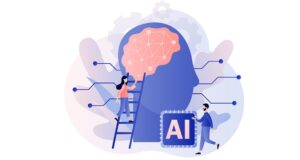AI in Drug Discovery: Transforming Pharmaceutical Research and Development
Artificial intelligence is shaking up the way scientists discover new medicines, making things faster and, honestly, a bit more efficient than ever. Instead of slogging through thousands of possibilities in a lab, AI can sift through massive piles of data and highlight promising drug candidates in record time.
This means important treatments could reach patients sooner—and maybe even at a lower cost, which is something everyone can get behind.
Researchers now use AI to design and fine-tune drug molecules, pick the right targets, and predict how safe or effective new drugs might be.
Pharmaceutical companies are weaving AI into nearly every stage of the drug discovery process.
With recent leaps in generative AI and large language models, researchers can chase down new ideas and build better medicines than before. The possibilities feel endless sometimes.
Key Takeaways
- AI is transforming how drugs are discovered and developed.
- It speeds up drug research and helps lower costs.
- Researchers use AI to find and design new medicines.
Overview of AI in Drug Discovery
Artificial intelligence is flipping the script on how new medicines are found. Researchers can now spot promising drug candidates and tear through mountains of data with a speed and precision that wasn’t possible.
Key Algorithms in Drug Discovery
Machine learning sits at the heart of drug discovery these days. These algorithms can sort through chemical libraries, predict molecular properties, and flag compounds that might actually treat diseases.
Deep learning is the go-to for crunching complex biological data, like protein structures. Support vector machines and random forests are also in the mix—they help classify molecules and predict drug activity.
Neural networks model how drugs and biological targets interact, which is a pretty wild leap from how things worked even a decade ago.
AI tools now use natural language processing to read scientific literature and surface new drug targets. By automating repetitive tasks, these algorithms make the whole development process faster and help researchers make sense of complicated decisions in the pharmaceutical industry.
Benefits and Advantages of AI for Drug Discovery
AI speeds up the hunt for new drugs by scanning and interpreting massive datasets in a flash. That saves time and resources, letting researchers zero in on the most promising leads instead of just guessing.
AI-based systems can predict if a drug molecule will be safe and effective, cutting down the risk of late-stage failures. That means fewer wasted resources and, hopefully, lower development costs.
AI also helps with drug repurposing—finding new uses for medicines we already have. It’s helping researchers develop custom treatments by analysing genetics, which could mean more options for people with tough-to-treat illnesses. If you want to dive deeper, check out this report on AI in drug development.
The Drug Discovery Process and AI Integration
Artificial intelligence now plays a big role in drug research. It helps manage data, speed up experiments, and cut costs.
Researchers can test heaps of chemical compounds on computers before heading to the lab, which boosts accuracy and makes it easier to pick out possible medicines.
Stages of the Drug Discovery Process
The process starts with target identification—scientists decide which biological piece to focus on. Then comes screening chemical compounds to see which ones affect the target.
After that, the hit compounds go through safety and strength tests in labs and animal studies. Promising candidates move into pre-clinical and clinical trials to check for effectiveness and side effects.
Each stage can drag on for years and burn through a lot of money. Mistakes or failures send everyone back to square one, which is frustrating and expensive.
AI is now making each phase more focused and data-driven, which can speed things up and cut costs.
Role of Data Collection and Data Sets
Modern drug discovery leans hard on collecting and analysing huge data sets from all over. AI systems pull data from experiments, patient outcomes, genomics, and chemical databases to spot patterns and predict what could work as a medicine.
Good data matters—a lot. Bad data can lead to wrong predictions and wasted effort.
Machine learning lets researchers clean up and organise these massive data sets faster than ever. This helps them spot strong drug candidates earlier, and the bigger and better the data sets, the smarter the AI models get.
In Silico Methods and High-Throughput Screening
In silico methods run computer models to test thousands of chemical compounds in a snap. These simulations can predict how drugs might interact with their targets, skipping a bunch of costly lab work.
High-throughput screening (HTS) brings in robotics and computers to test hundreds or thousands of molecules fast.
AI makes both in silico studies and HTS smarter by predicting which molecules are more likely to succeed. That means fewer chemicals need to be made and tested in the real world, saving time and money.
Using AI in these steps speeds up the discovery of new drug candidates and helps dodge expensive mistakes later on.
Enhancing Research and Development Efficiency
AI helps streamline research and development (R&D) by automating repetitive tasks, spotting patterns, and cutting down on human error.
Scientists use AI to make better calls at each step, from picking a drug target to planning clinical trials. AI predicts which compounds have the most potential and even suggests tweaks to make them better.
It also helps avoid duplicate work and gives early warnings about side effects or possible failures. The end result? A more cost-effective approach that gets new medicines to patients faster.
Companies using AI in R&D often see greater efficiency and a better shot at finding effective drugs.
AI Applications in Compound Identification and Optimisation
AI is guiding scientists to make smarter choices about which chemical compounds to test and how to improve them. It sharpens the search for new drug candidates and helps predict how these compounds might behave in the body.
Target Identification and Validation
AI systems can scan huge sets of biological data and spot potential drug targets, like proteins tied to diseases. Algorithms then check if these targets matter for the disease, helping scientists avoid wasting time and money in the lab.
Machine learning tools learn from past experiments, using patterns in genetic, protein, and clinical data. This makes finding true drug targets faster and more reliably.
AI also validates drug targets by sorting through patient data, scientific papers, and biochemical pathways. This boosts the accuracy of predicting useful drug targets, so research can be more focused.
Lead Generation and Compound Screening
AI can run virtual screens on millions of compounds, picking out those most likely to interact well with the chosen target. With this approach, researchers can skip testing so many compounds in the lab, saving a lot of time and money.
For lead generation, machine learning models find small molecules that stand a chance of becoming drugs. They comb through compound databases, ranking them by their odds of success.
This cuts down the number of experiments and bumps up the predictive power for finding good drug leads. AI-driven compound optimisation gives chemists ideas for tweaking the structure of leads, maybe boosting activity or cutting side effects.
Predicting Chemical Properties
AI tools are everywhere when it comes to predicting a compound’s chemical and physical properties—things like solubility, stability, or the ability to cross cell membranes. Getting a handle on these features early helps avoid late-stage failures.
Only the most promising compounds make it to the next step. Algorithms crunch big datasets from earlier tests to estimate how a drug candidate might behave in the body.
This leads to better accuracy of predictions and smarter selection of drug candidates. Tables and lists in these systems highlight which chemical features matter most, guiding further testing and optimisation.
Advancements in Biologics and Biotherapeutics
Artificial intelligence is shaking up how we develop biologics and biotherapeutics, offering new tools for identifying, designing, and testing complex molecules. These advances speed up antibody selection, RNA drug development, and protein structure prediction—sometimes in ways that still surprise even the experts.
Antibody Discovery and Engineering
AI-powered platforms now scan massive libraries of antibody sequences in just a few days. Machine learning algorithms predict which combinations will bind best to a target, letting researchers pick promising antibodies faster than ever before.
Once they find potential antibodies, AI models can suggest tweaks to improve specificity or reduce unwanted reactions. That means biotherapeutics with fewer side effects and better results.
Labs use structure-based modelling with AI to optimise antibodies for diseases like cancer and autoimmune conditions. AI doesn’t just speed up discovery—it also makes personalised therapies possible by matching antibodies to a patient’s unique needs.
Companies like AstraZeneca are already using AI for de novo biologic design, cutting down time and costs for new drug candidates. If you’re curious, check out this article on AI in biologics discovery and design.
RNA-Based Therapeutics
AI is making waves in RNA therapeutics by creating, editing, and understanding RNA molecules used in treatments. These therapies target diseases at the genetic level, opening doors that traditional drugs just can’t unlock.
AI tools analyse transcriptomics data to spot new RNA targets tied to disease. Algorithms then design small interfering RNA (siRNA) or messenger RNA (mRNA) drugs that can turn genes on or off, which is key for developing vaccines and gene therapies.
AI boosts the ability to predict how RNA therapeutics will interact with cells, cutting the risk of unwanted immune responses and helping fine-tune drug delivery. As a result, researchers are building more precise and safer RNA-based biotherapeutics with the help of artificial intelligence. There’s more on this in the overview on AI’s role in drug discovery and development.
Protein Structure Prediction
Predicting protein structures accurately is crucial for designing better biologics and biotherapeutics. AI models like AlphaFold have made these predictions way faster and more precisely.
Researchers use these models to figure out how a protein’s shape connects to its function or how a drug might bind. This helps scientists design engineered proteins that could work as drugs.
AI breaks down structures that used to be too tough or time-consuming for older methods. That’s opened up new ways to treat diseases tied to misfolded proteins and to create next-gen drugs. The field’s moving quickly, as detailed in this article on highly accurate protein structure prediction using AI.
Generative AI and Large Language Models in Drug Design
Generative AI and large language models are shaking up how researchers invent and improve new drugs. These tools generate possible drug molecules and predict if those candidates will be effective or safe.
Molecule Generation and Optimisation
Generative AI systems, like deep generative models, can quickly create tons of new molecules that might work as medicines. They scan huge chemical datasets and help scientists find compounds that fit certain targets in the body.
This approach is way faster than traditional drug development. These tools don’t just spit out ideas—they tweak molecules to improve how well they work, how easy they are to make, and how safe they are.
Large language models join in by predicting the effects of chemical changes or suggesting tweaks based on research papers. Pharmaceutical companies now use these AI models to sift through options at a pace that just wasn’t possible before, as highlighted in recent research.
Predicting Efficacy and Safety
Once new molecules are generated, AI and language models predict if they’ll actually help patients and if they might cause problems. These models pull from past studies, chemical databases, and even electronic health records.
They look at how a drug interacts with targets, whether it avoids unwanted reactions, and if its chemical structure hints at past safety issues. Generative AI flags risky compounds early, saving time and resources. By using language models this way, researchers boost the odds that their picks will have high efficacy and low safety risks, as industry experts discuss.
Clinical Development and Real-World Data
Artificial intelligence is changing how scientists run clinical trials, use real-world data, and measure the chances of success for new medicines. By mixing advanced data science with real-world insights, drug development is getting faster and more precise.
AI in Clinical Trial Design
AI helps researchers design better clinical trials by quickly scanning big piles of patient data. Unlike manual methods, AI can spot patterns and suggest which patients are most likely to respond to a treatment.
This makes patient selection more accurate and can lower the risk of failed trials. AI models also improve trial protocols by predicting the best trial sizes, locations, and likely hurdles.
With these tools, teams make faster decisions, save money, and improve patient safety. Clinical genomics and smart algorithms help trial designers match treatments to patient groups, which leads to more effective trials.
Large companies are using AI to speed up timelines and cut costs in drug development. As noted by industry experts, AI is already transforming clinical trial strategies.
Integration of Real-World Data
Real-world data (RWD) includes info from medical records, insurance claims, wearables, and patient surveys that come from outside standard clinical trials. RWD lets researchers see how drugs work in everyday healthcare and among diverse groups.
By combining RWD with AI, developers can spot rare side effects and find new uses for medicines. Data science tools chew through huge datasets to give insights that guide clinical development.
This combo allows for more flexible study designs and quicker feedback on drug safety and effectiveness. The use of AI and RWD is now seen as vital for drug development progress. Regulators and pharmaceutical companies lean on this data for drug approval and post-market studies.
Evaluating Probability of Success
Estimating how likely a new drug is to succeed is a tough part of clinical development. AI systems scan data from past trials, real-world outcomes, and patient characteristics to predict which drugs are most likely to make it.
Key factors AI checks:
- Clinical trial design features
- Patient response patterns
- Outcomes from similar drugs
- Early safety signals
These insights help companies decide which drugs to back or move forward in clinical stages. By using data from both trials and real-world sources, AI supports smarter decisions and may cut the costs of failed projects. Pharma teams now use AI-based models to optimise and assess clinical trial success through the drug development process.
Therapeutic Areas Driving Innovation
Artificial intelligence is pushing drug discovery forward by finding new therapeutic molecules and improving existing treatments. It’s changing how researchers tackle diseases like cancer, neurological conditions, and infectious diseases.
Applications in Oncology
Oncology is one of the main areas where AI really shines. Researchers use AI to analyse massive datasets from tumour genomics, patient records, and drug responses.
AI helps spot new drug candidates that can target cancer cells with more accuracy. It also predicts how patients might respond to certain treatments, supporting more personalised care.
This has sped up progress in new treatments and clinical trials for different cancer types. For example, advanced algorithms can screen thousands of compounds and highlight those with the most promise for certain tumours.
These tools also help researchers understand resistance mechanisms, giving patients better outcomes over time. Oncology keeps benefiting from AI as more data rolls in and models get smarter. If you’re curious, check out how AI targets oncology and other key areas.
Expansion to New Therapeutic Areas
AI isn’t just for cancer. It’s now being used in neurology, infectious diseases, and rare conditions—areas where treatment options are pretty limited.
In neurology, AI is helping find drugs for Alzheimer’s and Parkinson’s disease. For infectious diseases, it has sped up the hunt for antiviral and antibacterial compounds, as we saw during COVID-19.
AI models sift through complex biological data to spot effective molecules and predict side effects earlier. As its use grows, more diseases can be targeted with innovative solutions, cutting down both the time and cost of new therapies. You can read more about AI’s role in expanding drug discovery.
Pharmacokinetics and Safety Assessment
AI tools are changing how we look at drug safety and pharmacokinetics. These methods let scientists predict how drugs behave in the body and spot harmful side effects before clinical testing.
Modelling Absorption, Distribution, and Metabolism
AI models use big datasets from animals and humans to predict the absorption, distribution, and metabolism of new drug molecules. Machine learning algorithms look at molecular structure and chemical properties to estimate how fast a drug enters the bloodstream, spreads through tissues, and gets broken down.
With AI, scientists can now test new compounds virtually to see if a drug will be absorbed well or might cause metabolic problems. This step shortens the time spent in the lab.
Recent advances, like deep learning, help improve drug safety by flagging possible toxic effects early. These methods are already in use for both small and large molecules, boosting safety and efficiency in drug research. More about these models is in recent reviews on AI for pharmacokinetics prediction.
Industry Impact and Future Trends
Artificial intelligence is shaking up how drugs are discovered, tested, and approved. The main drivers here are biotech companies and teams building new AI technologies.
The Role of Biotech Companies
Biotech firms are leading the push for AI in drug discovery. They use AI to search for new compounds, design molecules, and predict how drugs will act in the body. That speeds up research and helps dodge costly mistakes.
Lots of biotech companies now use AI to screen massive databases for potential drug candidates. They also pull from medical imaging and genetics to make smarter calls about which projects to chase.
AI-driven platforms make it easier for smaller companies to compete with the big pharma players. Start-ups can test ideas quickly and pivot if the data says so. Because of this, partnerships between biotech firms and larger drug makers are on the rise.
Emerging AI Tools and Technologies
AI tools keep changing quickly. Machine learning algorithms now help scientists analyse chemical structures and model drug interactions with impressive accuracy.
These tools can sift through millions of molecules in a fraction of the time people would need. That’s a huge leap for research speed.
Imaging technologies paired with AI, like automated analysis of X-rays and MRI scans, speed up both preclinical and clinical testing. Researchers can now track how a drug affects tissues or tumours in real time and make decisions much earlier in the process.
New AI platforms use deep learning and natural language processing to scan scientific literature and patent databases for fresh ideas. Some even predict side effects or help design clinical trials by picking out the best patient groups.
Companies working on these tools hope to cut costs and boost the chances that a new drug will succeed in patient testing. If you want to dig into current trends and what might come next, check out AI in Pharma and Biotech: Market Trends 2025 and Beyond.
Challenges and Limitations of AI in Drug Discovery
AI has changed how scientists find and develop new drugs, but there are some real obstacles. Data isn’t always easy to access or use well, and rules from health agencies can slow things down.
Data Quality and Availability
High-quality data is essential for AI to deliver useful results in drug discovery. Many organisations have incomplete or inconsistent data, and a lot of it sits behind paywalls.
This lack of data sharing makes it tough for AI models to learn patterns accurately. For AI to work well, the data has to be not only big in quantity but also correct and up to date.
Errors or missing details can lead to false predictions, which can slow down safe drug development. The CEO of Verseon points out that strong experimental data is vital because AI models can’t replace careful science and lab work.
Things get even trickier when different companies use their own formats, making it hard to combine or compare information. For more about these issues, see the discussion of data challenges in drug discovery.
Regulatory Considerations
Drug companies have to follow strict rules before any medicine can reach patients. When AI gets involved, regulators want to know exactly how it makes decisions.
This isn’t always easy, since some AI methods—especially deep learning—are like “black boxes” and tough to explain. Regulatory agencies also want proof that AI tools are safe, reliable, and trustworthy.
No widely accepted standards or best practices exist yet for using AI in drug approval. So, every new use of AI might need extra review and explanation, which tends to slow things down.
Health systems and agencies are working on these issues, but progress is slow because AI technology keeps changing so fast.
Frequently Asked Questions
Artificial intelligence is shaking up drug discovery by cutting the time and costs needed to find effective medicines. It uses advanced algorithms to analyse data, predict outcomes, and support better decisions in pharmaceutical research.
How can artificial intelligence accelerate the process of drug discovery?
AI systems can quickly process and analyse huge datasets, including chemical libraries and biomedical information. This makes it possible to spot promising drug candidates much faster than traditional methods.
Automated platforms can also test compounds and predict their effects, speeding up early-stage research in a big way.
In which ways has artificial intelligence contributed to the development of new pharmaceuticals?
AI has helped researchers find new drug targets by analysing complex biological data. It can uncover links between diseases and genetic markers.
AI also helps create molecules that may interact with these targets, raising the odds of finding successful drug candidates. Advanced models make it easier to repurpose existing drugs for new uses.
What are the primary benefits of integrating AI into pharmaceutical research and development?
Bringing AI into drug research can improve efficiency, cut costs, and boost success rates for developing new medicines. AI helps predict how well a drug will work and can catch safety issues much earlier.
Researchers also use AI to optimise drug dosages and pick patients who are most likely to benefit from a treatment, as shown here.
Which algorithms or AI techniques are most effective in predicting drug-target interactions?
Machine learning models like deep learning neural networks and random forest algorithms are widely used to predict drug-target interactions. Support vector machines (SVMs) and decision trees are also pretty popular.
These algorithms can handle large volumes of data and spot patterns that help identify how drugs will interact with specific targets.
How does AI improve the accuracy of predictive modelling in drug design?
AI improves accuracy in drug design by learning from huge datasets on chemical structures and biological responses. It can model how new molecules might behave in the body, which allows for better predictions of a drug’s effect and safety.
This leads to fewer failed experiments and saves time during drug development. Not bad, right?
Can you cite some examples where AI technology has played a crucial role in discovering new drugs?
AI has jumped in to help identify drug candidates for diseases like COVID-19 and several types of cancer.
Some pharmaceutical companies have even used AI to design molecules, and a few of those have actually entered clinical trials.
If you’re curious about how AI is changing drug discovery, you can check out more details in this overview or dive into this detailed guide.





















